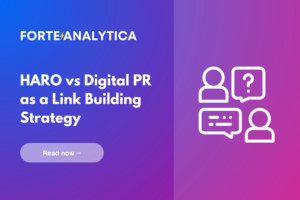In today’s ever-evolving digital world, it’s important to stay ahead of your competitors. One way to do this is through an effective PR strategy. But, with so many options available, it can be difficult to know which one is right for you.
Read on to explore the difference between reactive PR vs proactive PR for SEO, what they entail, and how they can benefit your business.
What is reactive PR?
Reactive PR is when a company’s PR strategy focuses on responding to news stories or events that may affect its brand or industry.
This method requires the ability to react quickly and efficiently to a situation, with the goal of protecting the company’s reputation. It means your company is waiting for something to happen before responding to it.
Read more on what reactive PR is with examples and how you can scale your reactive PR campaigns.
Impact on SEO
Reactive PR can have a positive impact on SEO by generating media coverage and increasing brand awareness. This coverage can then lead to backlinks, which are crucial for improving search engine rankings. However, the links may not be of high quality, and the timing of the coverage may not always align with your SEO strategy.
What is proactive PR?
Proactive PR, on the other hand, is a strategy focused on identifying and targeting opportunities to control the narrative and generate positive awareness.
It requires the ability to anticipate and craft a message ahead of time that aligns with the company’s values and goals. It means your company is taking the initiative to create and tell its own story.
Impact on SEO
Proactive PR has a much greater impact on SEO because it allows companies to control the narrative and target specific keywords. By crafting a message that aligns with the company’s values and goals, proactive PR can generate high-quality backlinks that contribute to improving search engine rankings.
Which approach is best for your business?
Both reactive PR and proactive PR have their advantages and disadvantages, and the choice between them ultimately depends on your business’s unique needs and goals.
For example, if you have limited resources and a reactive approach may be more feasible. If you have a specific message you want to promote, a proactive approach may be more effective.
Here are some questions to ask yourself to determine what PR approach best fits your business:
- What is the company’s primary goal?
- What resources are available for PR?
- What is the target audience?
- What are the key messages that the company wants to convey to the public?
- What type of media outlets is the target audience most likely to use?
How to harness the power of reactive & proactive PR for SEO:
To maximize the benefits of both reactive and proactive PR, you should consider integrating them into your SEO strategy. Here are some ways to do that:
1. Use reactive PR to your advantage
By monitoring relevant news stories and events, you can craft a response that aligns with your company’s values and goals. Consider creating a plan for dealing with potential negative press, so you are ready to respond quickly and effectively when it happens.
2. Utilize proactive PR strategies
Determine key messages that your company wants to promote and identify appropriate channels and media outlets. Build relationships with journalists to pitch your story to the media and use linked images and videos to encourage people to share your content on social media platforms.
3. Link building
Link building is an essential component of SEO that can be done through both reactive and proactive PR. With reactive PR, you can leverage media mentions to secure backlinks to your site.
With proactive PR, you can pitch tailored content that can earn high-quality backlinks that are white-hat and editorial.
FAQs
What is the difference between reactive and proactive PR?
Reactive PR is when a company’s PR strategy focuses on responding to news stories or events that may affect their brand or industry. Proactive PR is a strategy focused on identifying and targeting opportunities to control the narrative and generate positive awareness.
Can reactive PR positively impact SEO?
Reactive PR can positively impact SEO by generating media coverage and increasing brand awareness. This coverage can then lead to backlinks, which are crucial for improving search engine rankings.
Is proactive PR better than reactive PR for SEO?
Proactive PR is better than reactive PR for SEO, as it allows companies to control the narrative and target specific keywords. By crafting a message that aligns with the company’s values and goals, proactive PR can generate high-quality backlinks that contribute to improving search engine rankings.
How can I integrate reactive and proactive PR into my SEO strategy?
To integrate reactive and proactive PR into your SEO strategy, consider using reactive PR to your advantage, utilizing proactive PR strategies, and implementing link building through both reactive and proactive PR strategies.


